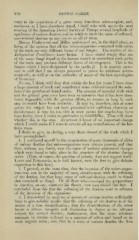Page 808 - My FlipBook
P. 808
818 . : DENTAL CARIES.
trary to the experience of a great many American microscopists, and,
moreover, as I have elsewhere stated, I shall take with me to the next
meeting of the American Dental Society of Europe several hundreds of
specimens of carious dentine, and be ready to show the areas of softened,
non-infected dentine on any one or on all of them.
Messrs. Underwood and ]\Iilles understand me, in the third place, as
being of the opinion that all the micro-organisms connected with caries
of the teeth are only different forms of one fungus. The readers of the
Independent Practitioner know better. I have stated simply that one
of the many fungi found in the human mouth in connection with caries
of the teeth may produce different forms of development. This is the
fungus which I have designated by the prefix /?. It is scarcely neces-
sary to add that I am ah\'ays prepared to prove its existence micro-
scopically, as well as on the authority of many of the best mycologists
of Germany.
No one, I think, will deny that wuthin the last few years I have done
a large amount of work and contributed some evidence toward the solu-
tion of the problem of dental caries. The amount of material dealt with
and the ground gone over have been so extensive that it has been abso-
lutely impossible, with the greatest efforts, to remain as long by each
step as would have been desirable. It may be, therefore, that at some
points the subject has not been presented with sufficient clearness or
it may be, too, that at some points the conclusions have
decisiveness ;
been faulty, since I make no pretension to infallibility. Time will show
whether this is the case. At present I know of no important change
wdiich I could make if I were to rewrite all my contributions of the last
three years.
I desire to give, in closing, a very short resume of the work which I
have accomplished
1 I convinced myself by the examination of some thousands of slides
of carious dentine that micro-organisms were always present, and that
they, without any doubt, were the cause of various anatomical changes
which Avere found to take place in the structure of the dentine during
caries. (Here, of course, the question of priority does not suggest itself:
Leber and Rottenstein, as is well known, were the first to give definite
expression to this fact.)
2. I proved, at the same time, that the invasion of the micro-organ-
isms was not, in the majority of cases, simultaneous with the softening
of the dentine, but that large areas of softened dentine could be found
that contained no fungi. Of all those who examined my preparations
in America, no one, whatever his theory, ever once denied this fact. I
concluded from this that the softening of the dentine went in advance
of the invasion of the organisms.
3. I determined by analyses of masses of carious dentine sufficiently
large to give reliable results that the softening of the dentine is of the
nature of a true decalcification ; that the decalcification of the outer
layers is almost complete and diminishes in degree as we advance
toward the normal dentine ; furthermore, that the same relations
maintain in dentine softened in a mixture of saliva and bread or in
weak organic acids ; also, that in a mass of carious dentine the lime


